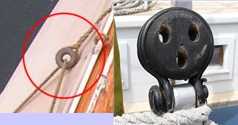


 C Home Glossary E
C Home Glossary E
Revised May 27 2021
 TFD: A round, flattish, wooden block, encircled by a rope, or an iron band, and pierced
with three holes to receive the
lanyard; used to extend the
shrouds and
stays, and for other purposes.
Called also deadman's eye.
TFD: A round, flattish, wooden block, encircled by a rope, or an iron band, and pierced
with three holes to receive the
lanyard; used to extend the
shrouds and
stays, and for other purposes.
Called also deadman's eye.
Divide the ship's company, exclusive of the marines, into as many divisions as there are lieutenants allowed to the ship; the divisions are to be equal in number to each other, and the men are to be taken equally from the different stations in which they are watched. A lieutenant is to command each division; he is to have under his orders as many master's mates and midshipman as the number on board, being equally divided, will admit; he is to sub-divide his division into as many sub-divisions as there are mates and midshipmen fit to command under his orders.
 C Home Glossary E
C Home Glossary E